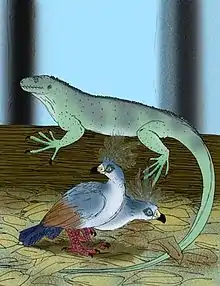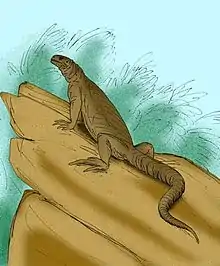Lapitiguana
Lapitiguana impensa is an extinct giant (1.5 m long) iguanid from Fiji.[1] It probably became extinct following the human colonization of Fiji 3000 years ago.[1]
| Lapitiguana Temporal range: Holocene | |
|---|---|
 | |
| Natunaornis and Lapitiguana | |
| Scientific classification | |
| Domain: | Eukaryota |
| Kingdom: | Animalia |
| Phylum: | Chordata |
| Class: | Reptilia |
| Order: | Squamata |
| Suborder: | Iguania |
| Family: | Iguanidae |
| Genus: | †Lapitiguana |
| Species: | †L. impensa |
| Binomial name | |
| †Lapitiguana impensa Pregill & Worthy, 2003 | |
All extant Fijian iguanas are in the genus Brachylophus, together with an extinct species from Tonga. The closest living relatives of the Polynesian iguanas are found in the Americas.[2][3]
See also
References
- Pregill, G. K.; Worthy, T. H. (March 2003). "A New Iguanid Lizard (Squamata, Iguanidae) from the Late Quaternary of Fiji, Southwest Pacific". Herpetologica. The Herpetologists' League. 59 (1): 57–67. doi:10.1655/0018-0831(2003)059[0057:ANILSI]2.0.CO;2.
- Keogh, J. Scott; Edwards, Danielle L.; Fisher, Robert N.; Harlow, Peter S. (2008-10-27). "Molecular and morphological analysis of the critically endangered Fijian iguanas reveals cryptic diversity and a complex biogeographic history". Philosophical Transactions of the Royal Society B. Royal Society. 363 (1508): 3413–3426. doi:10.1098/rstb.2008.0120. PMC 2607380. PMID 18782726.
- Noonan, B.P.; Sites, J.W. Jr. (2009-11-24). "Tracing the origins of iguanid lizards and boine snakes of the Pacific". The American Naturalist. University of Chicago Press. 175 (1): 61–72. doi:10.1086/648607. PMID 19929634. S2CID 5882832.
This article is issued from Wikipedia. The text is licensed under Creative Commons - Attribution - Sharealike. Additional terms may apply for the media files.
